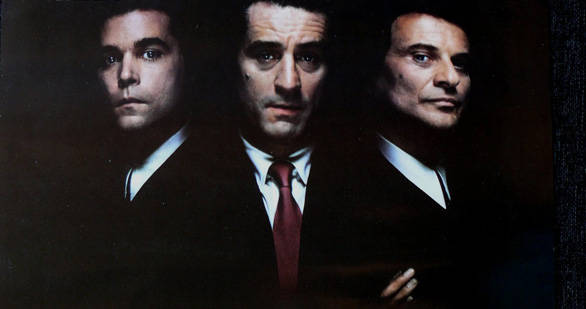A Conversation with the Creative Team Behind "Beyond Wiseguys: Italian-Americans and the Movies"
The film, which was Executive Produced by Rosanne DeLuca Braun and John Turturro, was broadcast last year on PBS. It deals with the many contributions and challenges that Italian-Americans have made in the movie industry. The film features an array of film luminaries such as Mr. Turturro, Marisa Tomei, Susan Sarandon, Martin Scorsese, Stanley Tucci, Ben Gazzara, Isabella Rossellini, with commentary by historians and scholars including - among others - Professor Fred Gardaphe and writer George DeStefano.
Recently, the film has been re-developed as an educational tool, featuring a dvd accompanied by a Teachers’ Guide, written by Professor Gardaphe. In honor of Italian-American history month, the film will have a special one-time only screening in Gloucester, MA on October 11 at the Cape Ann Community Cinema. I recently interviewed Ms. DeLuca Braun, Professor Fred Gardaphe and director Steve Fischler of Pacific Street Films, about the film.
CM- What lead you to make the film? What inspired it? How did Pacific Street Films get involved?
RB- When I curated a film festival focusing on the history of Italian Americans in Hollywood for Long Island's Cinema Arts Centre, it was awall- to -wall sellout, so I knew I was onto a story that needed telling. As I did the research, looking deeper into the intersection between the Italian immigrant experience and Hollywood history, I became inspired to tell the story of how Italians put their heritage, their experience and their creativity to work in the service of American movies. In caseyou haven't guessed, I'm Italian.
SF- Rosanne Braun came to Pacific Street Films with the idea of making a documentary about Italian Americansand the film industry. We thought it was interesting and a subjectthat hadn't really been explored in a serious way, so we partnered on the project.
CM- What was the experience of producing like? Your biggest challenge? Biggest reward?
RB- Producing the film, even though it was my first, was a lot like producing film festivals, of which I have done many: you bring together the best resources you can find, raise the money to support their work, ride herd on keeping the story and message intact, and somehow
get the whole thing to the finish line. Besides raising the money, which took several years, the biggest challenge was shaping our final hour-long film from the 40 hours of great interview materials we had from our celebrity guests. Thank god my co-producers, Steve Fischler and JoeSucher of Pacific Street Films, had more than enough experience and skill to make it happen. The biggest reward, of course, was sitting in theaters and hearing the audiences enjoy the film thoroughly.
SF- There were two challenges we faced in making the film. The biggest – often the case with documentaries -- is raising the money. This was difficult and helps account for the fact that it took a few years to make the film. Rosanne Braun spearheaded this effort and she worked tirelessly and successfully in making sure the film was completed. The second challenge was to take a history that spans over 100 years and involves countless people and shape it into a coherent and strong hour. What we ended up doing -- successfully we feel -- is combining the compelling interviews we conducted within a chronological framework that ranged from the early days of cinema to the Italian American filmmakers and artists working today.
CM- How did John Turturro come on board as an Executive Producer?
RB- I had gotten to know John during my work for the Cinema Arts Centre, and knew how strongly he felt about his own Italian-American background.
Once I put together the outline of the story I wanted to tell, I sent it to him. He called me almost immediately and signed on as Executive Producer. His involvement encouraged many other well-known film artiststo give us interviews, like Susan Sarandon, Stanley Tucci, Spike Lee, Ben Gazzara, Paul Sorvino.....almost everyone we met, in fact.
CM- What led you to create a Teachers Guide?
RB- The film deals with how Italian Americans are stereotyped in Hollywood movies, and how that affects Italian American filmmakers themselves, as well as American audiences, so it's a topic that applies to any racial or ethnic group and integrates perfectly into classes on history, social sciences, media and literature. It seemed a natural for high schools and colleges, and with Professor Fred Gardaphe's help, we were able to create a Teachers' Guide that assists teachers with classroom discussion, homework assignments and special projects.
FG- The main goal of the teachers guide is to aid teachers and discussion leaders in preparing the film for classroom use and to stimulate teachers’ own interpretations.
CM- What would you like to see happen as a result of the Teachers Guide?
RB- I think media literacy is one of the most important things that can be taught in our media-overloaded culture, so I hope that in a small way we are helping people to think about what they're consuming as popular culture stereotypes, and not just absorb them unthinkingly.
FG- I would like to see the guide used by teachers so that it would make their work a little easier. I also hope that it will inspire them to do other things with the materials.
SF- We would like to see teachers use the film and the teachers guide to discuss the way Italians and Italian-Americans are represented -- and misrepresented -- in popular culture. There has been a prevailing stereotypical and demeaning association with ItalianAmericans and this needs to presented in a direct and responsible manner.
Check out the trailer for the film here.





































i-Italy
Facebook
Google+
This work may not be reproduced, in whole or in part, without prior written permission.
Questo lavoro non può essere riprodotto, in tutto o in parte, senza permesso scritto.